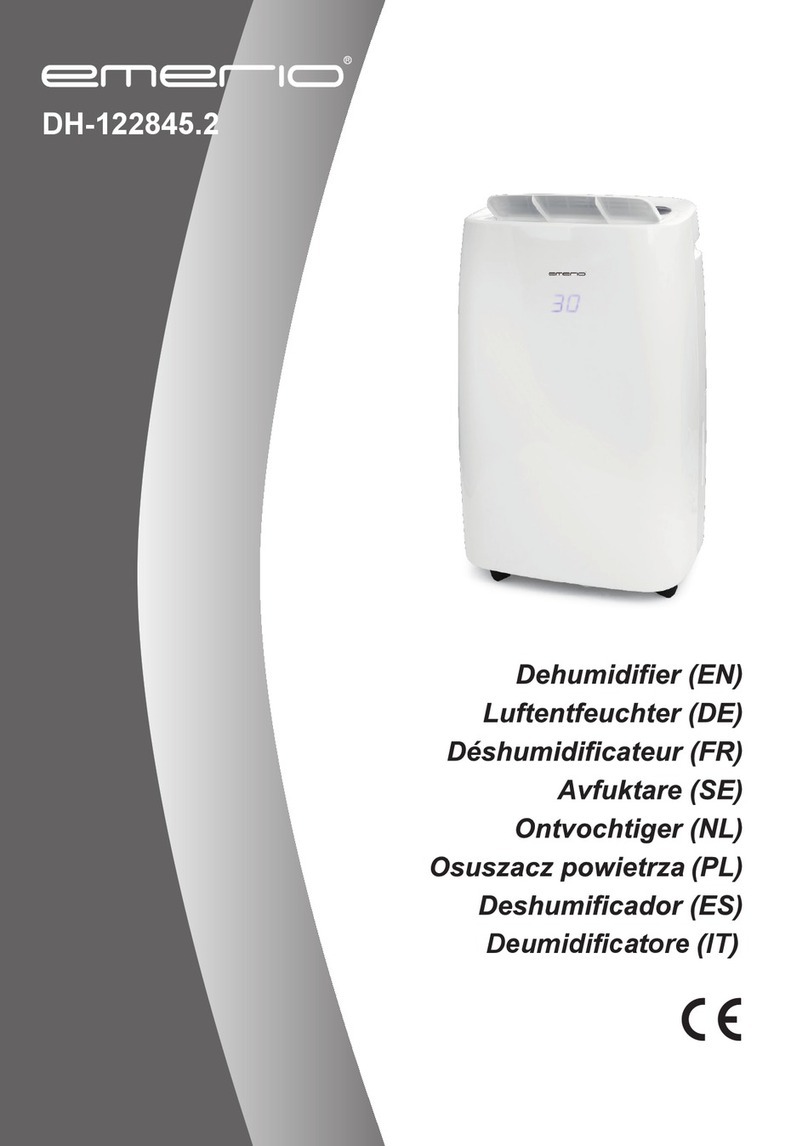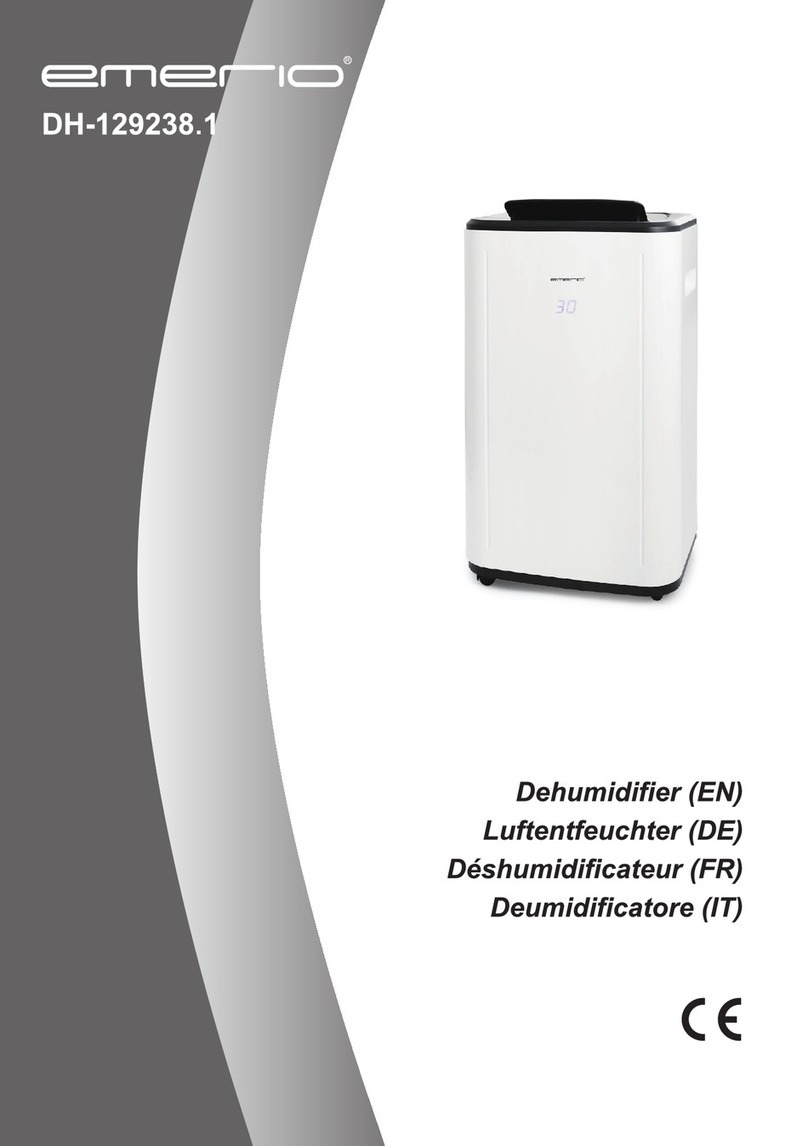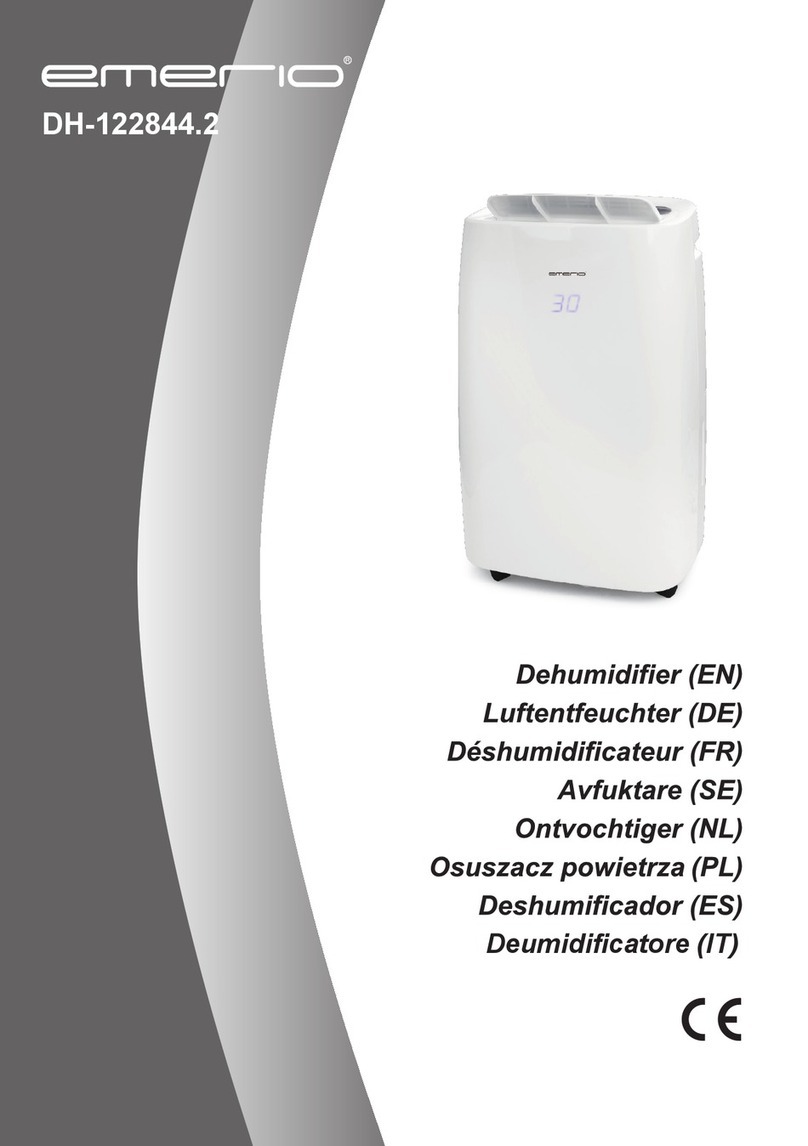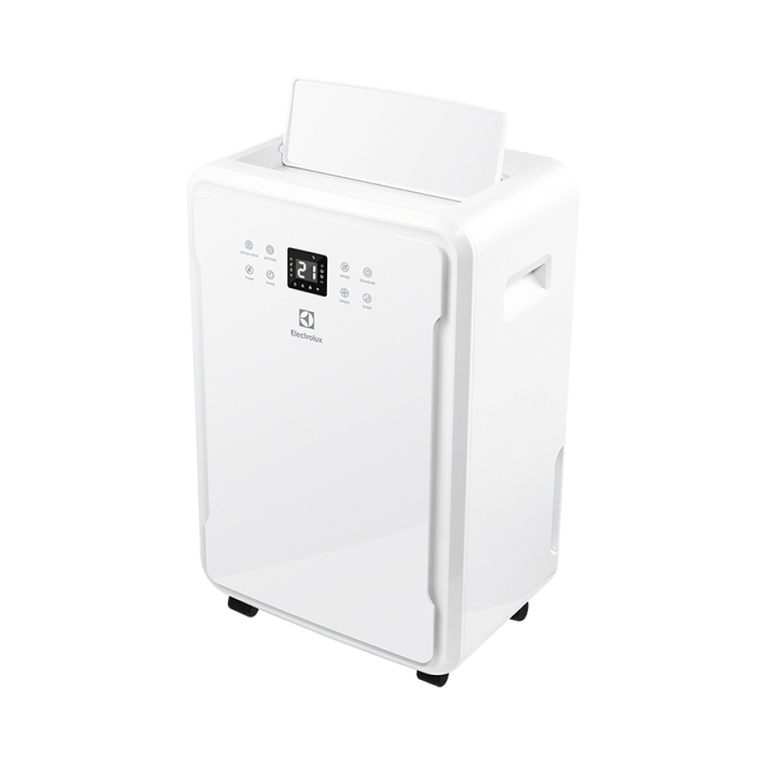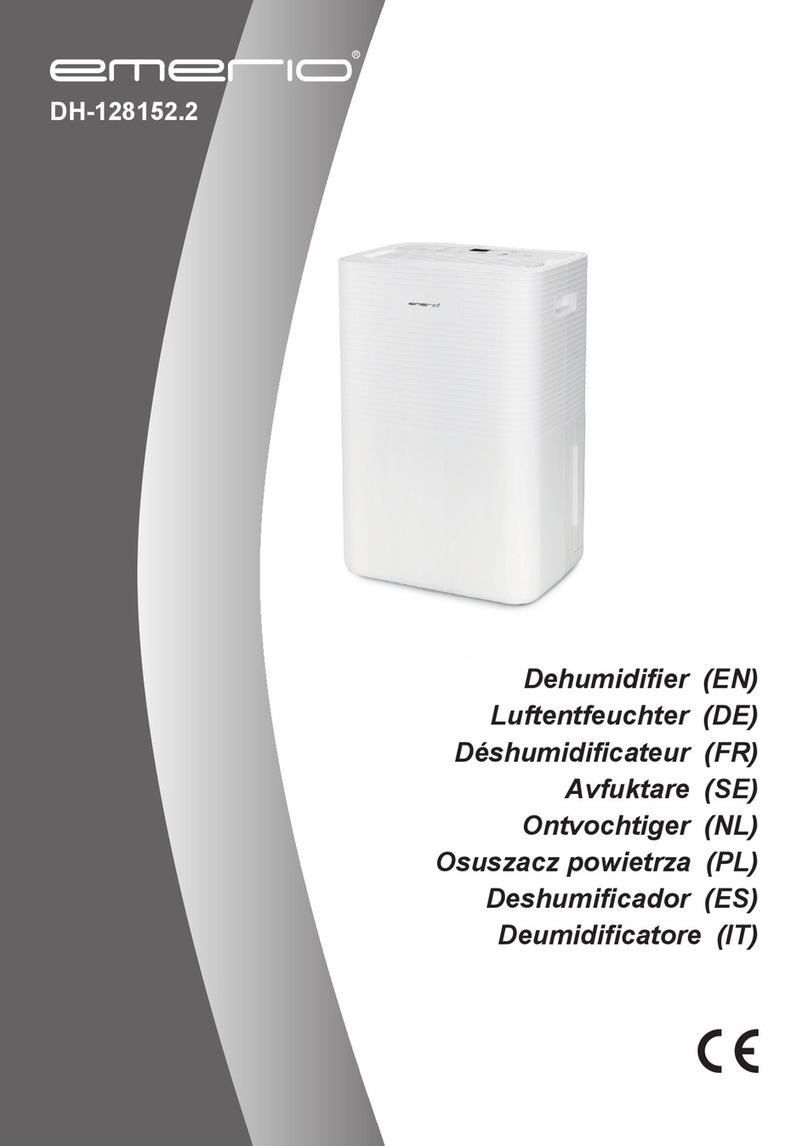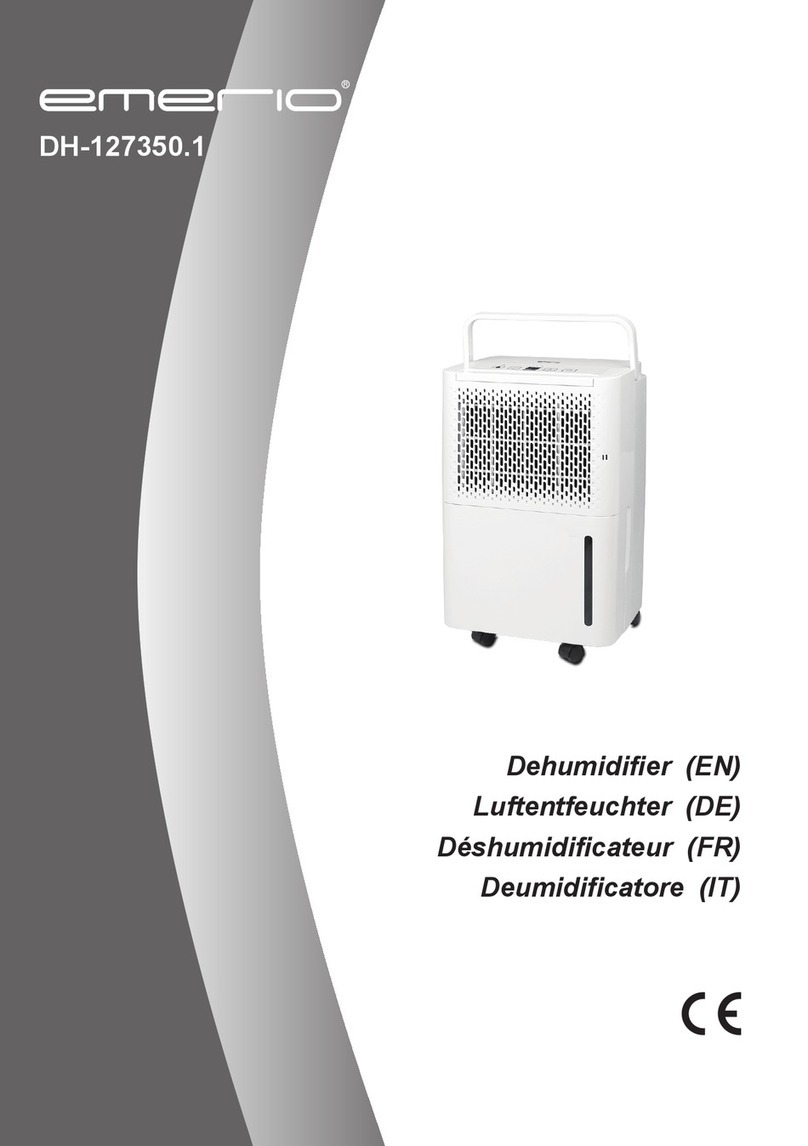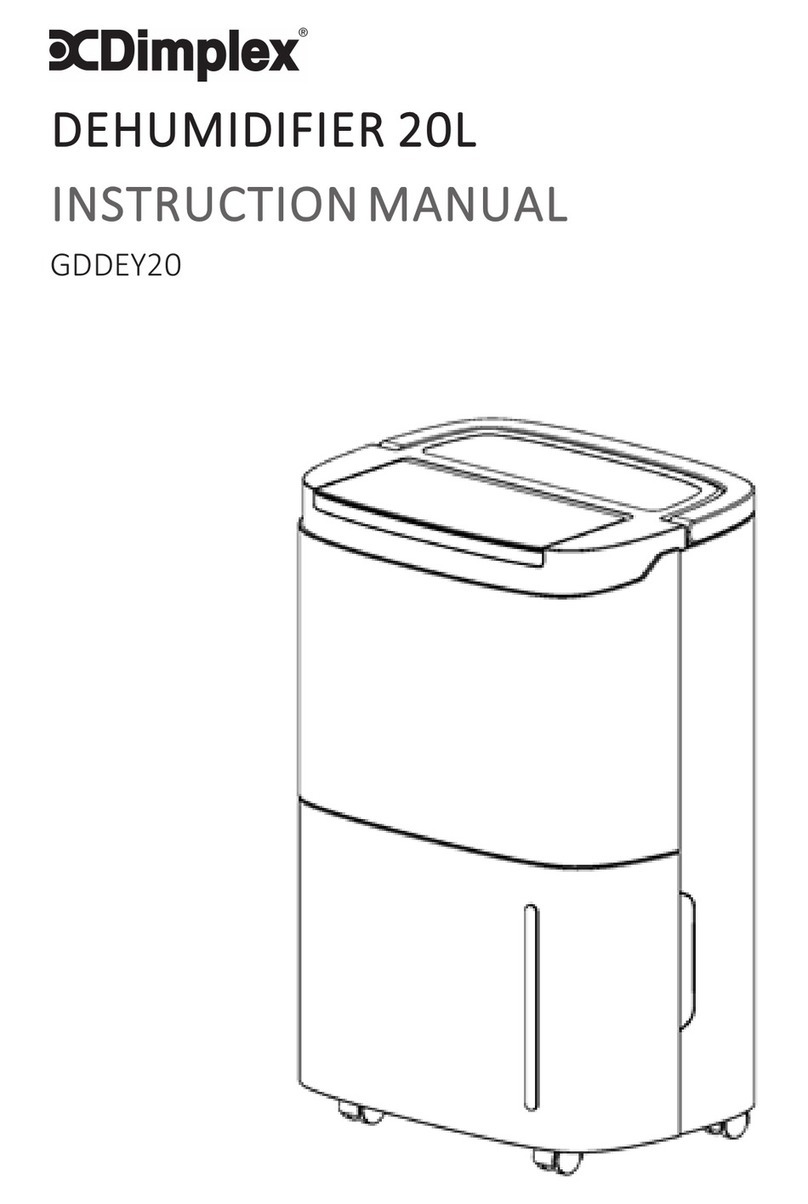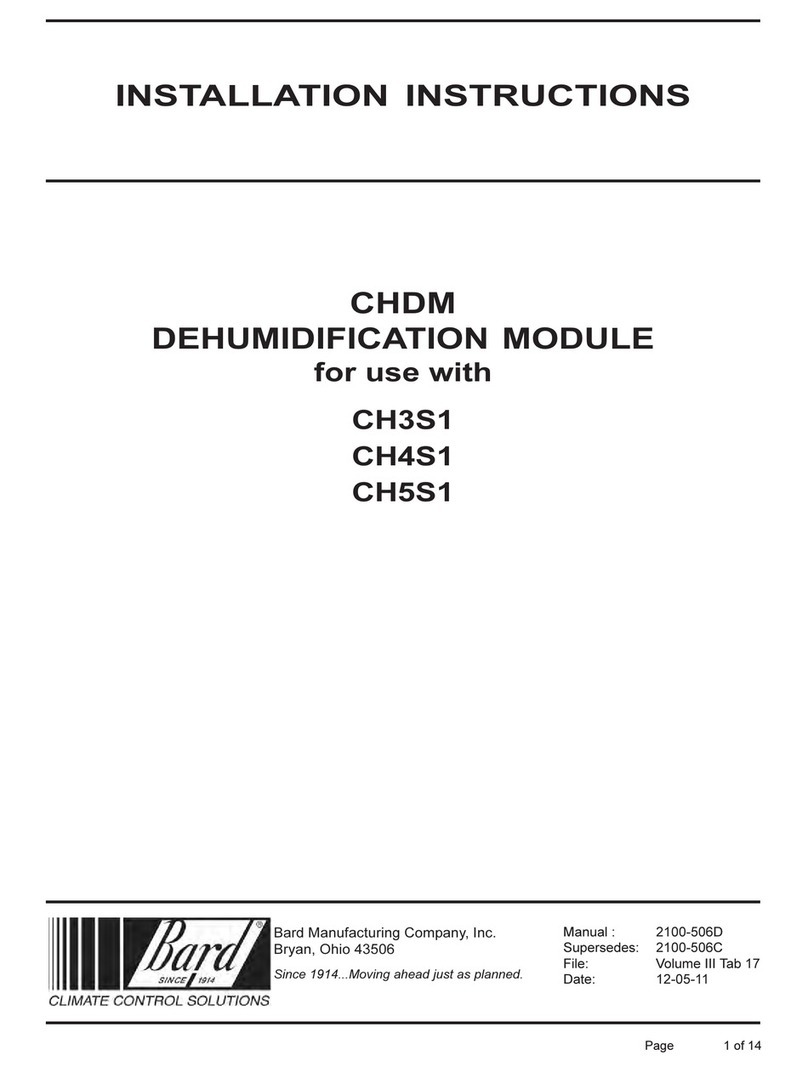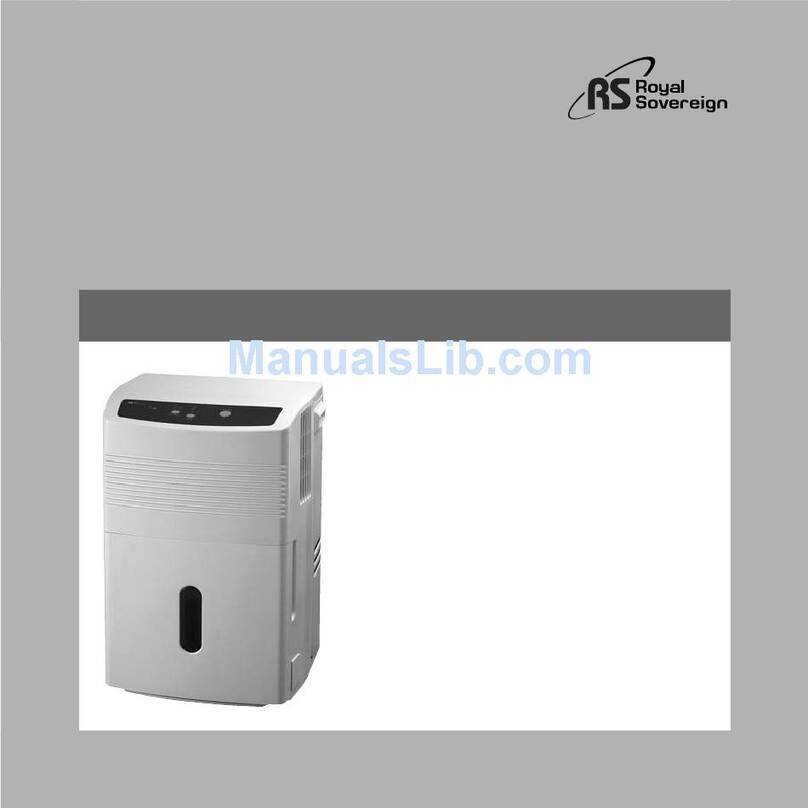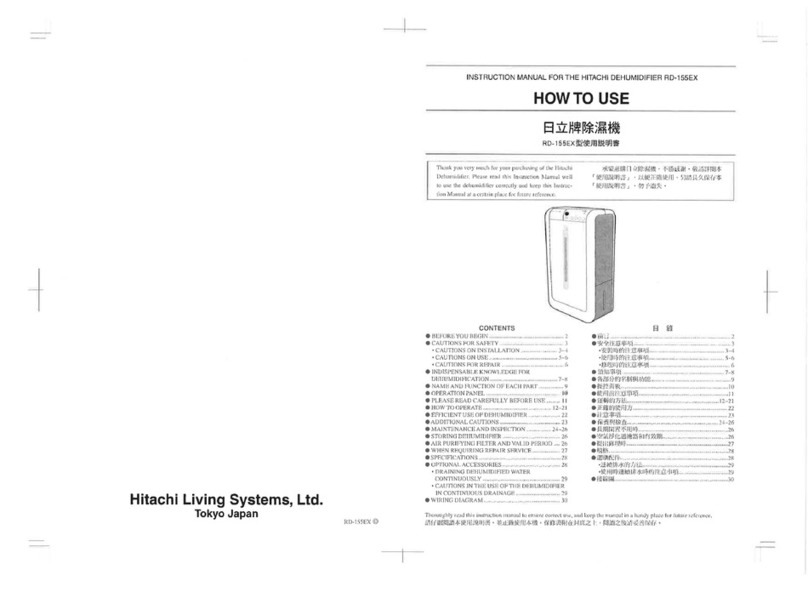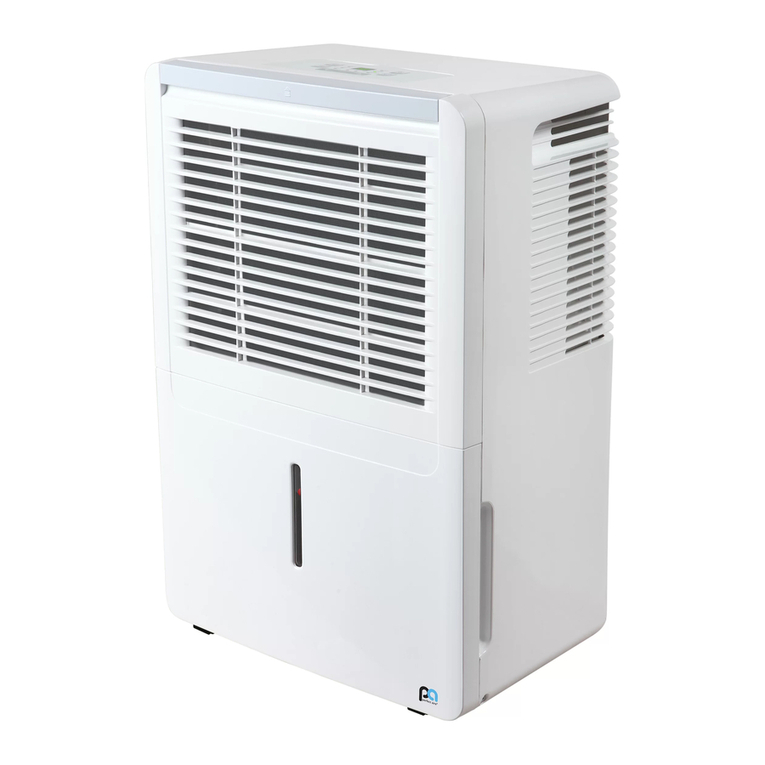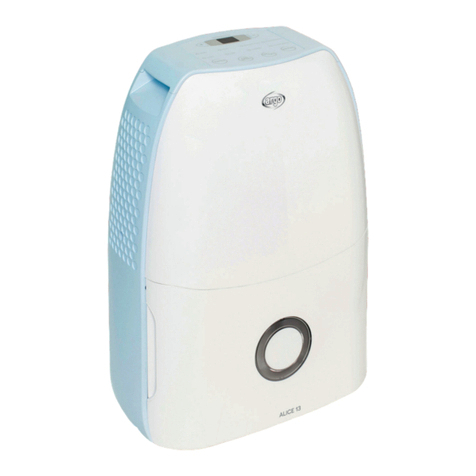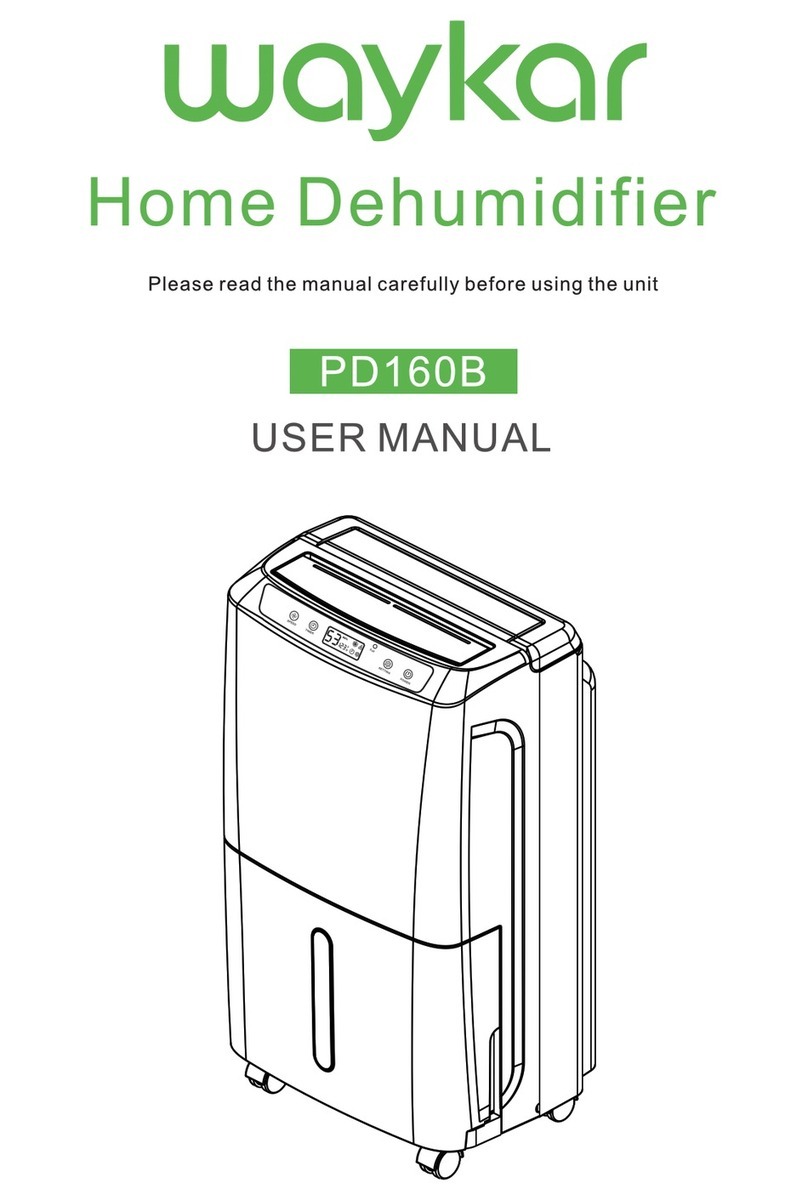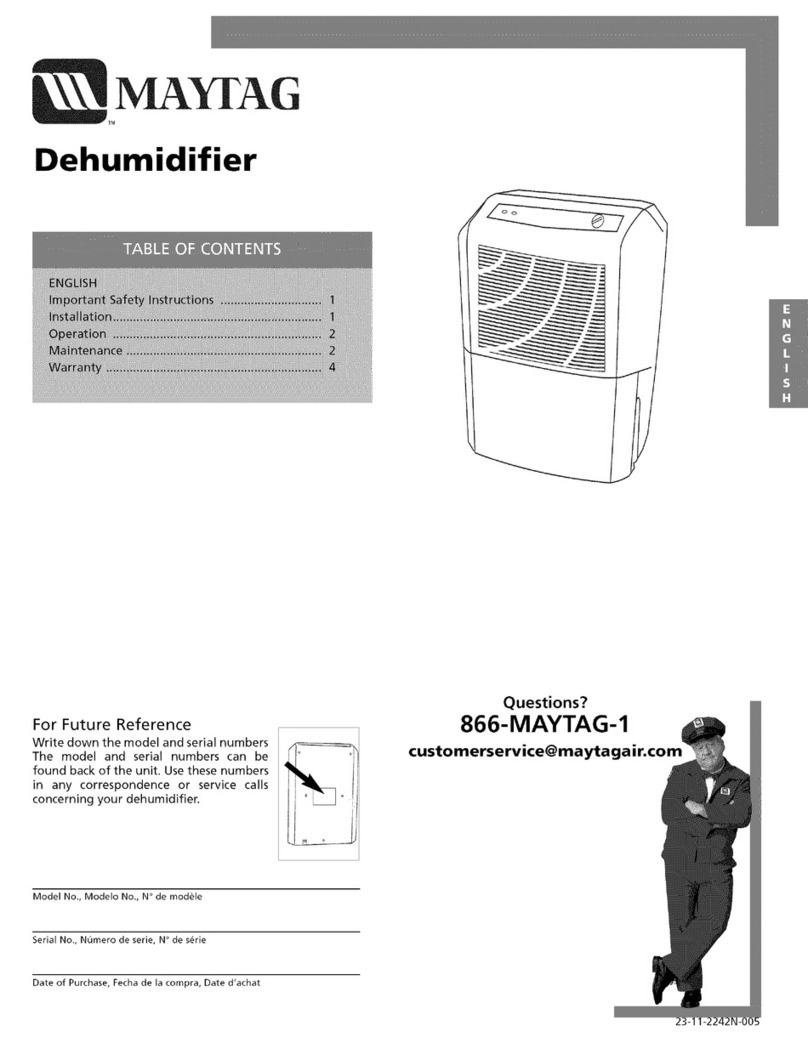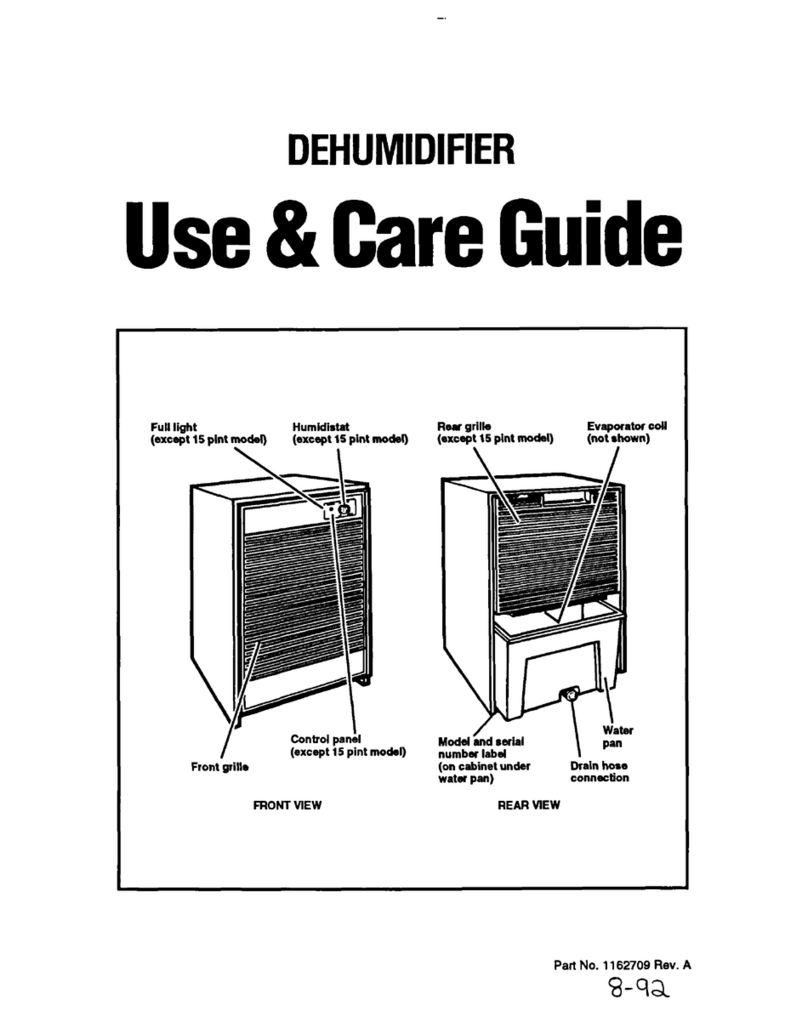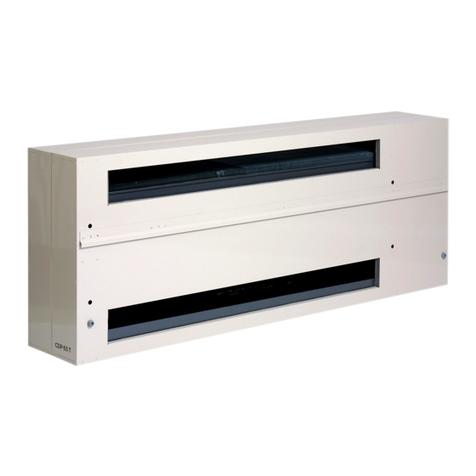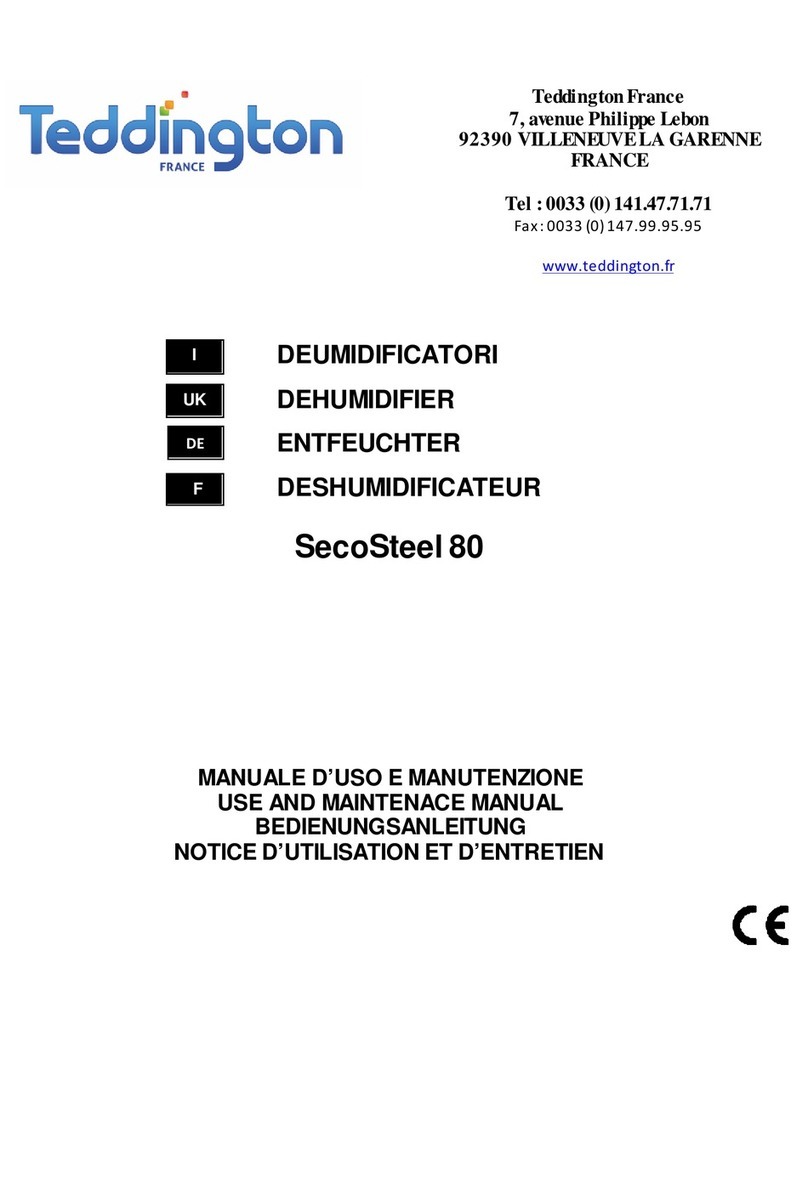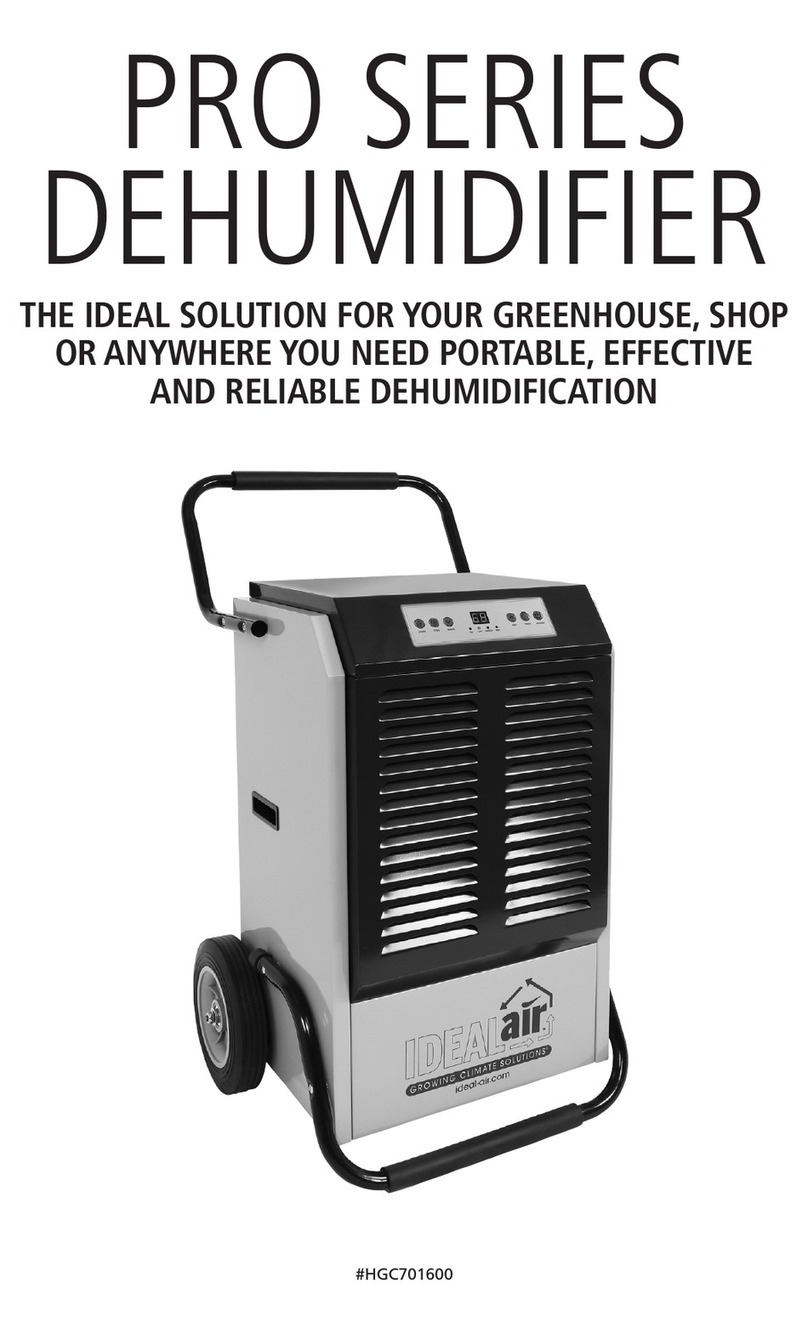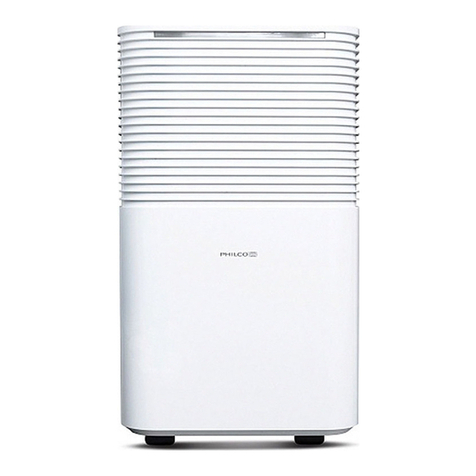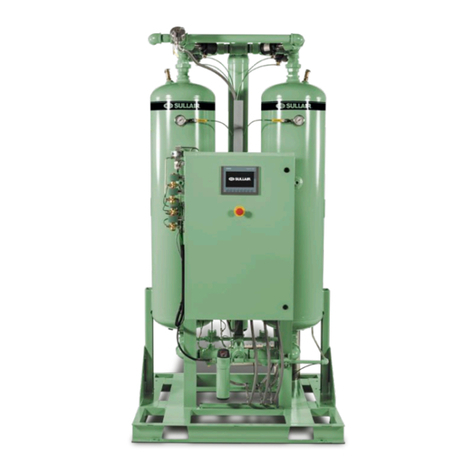emerio DH-126050.1 User manual


- 1 -
Content – Inhalt – Contenu – Contenuto
Instruction manual –English ......................................................................................- 2 -
Bedienungsanleitung –Deutsch...............................................................................- 18 -
Mode d'emploi –Français ........................................................................................- 37 -
Manuale d'istruzioni –Italiano.................................................................................- 56 -

- 2 -
Instruction manual –English
Thank you very much for purchasing our products. In order to
ensure correct operation, please read this manual and
instruction carefully before use.
IMPORTANT INSTRUCTIONS
When using electrical appliances, basic precautions should
always be followed to reduce the risk of fire, electric shock,
burns and other injuries.
1. Read and save these instructions. Attention: pictures in the
IM are for reference only.
2. This appliance can be used by children aged from 8 years
and above and persons with reduced physical, sensory or
mental capabilities or lack of experience and knowledge if
they have been given supervision or instruction concerning
use of the appliance in a safe way and understand the
hazards involved.
3. Children shall not play with the appliance.
4. Cleaning and user maintenance shall not be made by
children without supervision.
5. If the supply cord is damaged, it must be replaced by the
manufacturer, its service agent or similarly qualified
persons in order to avoid a hazard.
6. Before inserting the plug into the mains socket, please
check that the voltage and frequency comply with the
specifications on the rating label.
7. If an extension cord is used it must be suited to the power
consumption of the appliance, otherwise overheating of
the extension cord and/or plug may occur. There is a
potential risk of injuries from tripping over the extension
cord. Be careful to avoid dangerous situations.
8. Disconnect the mains plug from the socket when the
appliance is not in use and before cleaning.
9. Ensure that the mains cable is not hung over sharp edges
and keep it away from hot objects and open flames.

- 3 -
10. Do not immerse the appliance or the mains plug in water
or other liquids. There is danger to life due to electric shock!
11. To remove the plug from the plug socket, pull the plug. Do
not pull the power cord.
12. Do not touch the appliance if it falls into water. Remove the
plug from its socket, turn off the appliance and send it to
an authorized service center for repair.
13. Do not plug or unplug the appliance from the electrical
outlet with a wet hand.
14. Never attempt to open the housing of the appliance, or to
repair the appliance yourself. This could cause electric
shock.
15. This appliance is not designed for commercial use. Indoor
use only.
16. Do not use the appliance for other than intended use.
17. Do not wind the cord around the appliance and do not
bend it.
18. Do not use this appliance in a window as rain may cause
electric shock.
19. Disconnect the power if strange sounds, smell or smoke
comes from it.
20. Switch off the appliance before changing its position.
21. Do not put heavy objects on the appliance.
22. Do not cover the intake or exhaust opening with cloths or
towels.
23. Do not drink or use the water drained from the unit.
24. Do not take the water tank out during operation.
•Empty the water tank before moving the unit to avoid
water spilling.
•Do not tilt the unit to prevent water from spilling and
damaging the machine.
•Do not insert any foreign objects to enter any opening,
as this may cause an electric shock, fire or damage to the
appliance.
25. Do not put the unit close to heat-generating devices or near
flammable and dangerous materials.

- 4 -
26. Never put your fingers or objects into the air inlet or air
outlet.
27. Do not operate the dehumidifier in a closed area such as
inside a closet, as it may cause a fire.
28. The appliance shall be installed in accordance with national
wiring regulations.
29. Details of type and rating of fuses:AC 250V,3.15A,T/ AC
250V,3.15A,F.
30. Servicing shall only be performed as recommended by the
equipment manufacturer. Maintenance and repair
requiring the assistance of other skilled personnel shall be
carried out under the supervision of the person competent
in the use of flammable refrigerants.
31. Do not use means to accelerate the defrosting process or
to clean, other than those recommended by the
manufacturer.
32. The appliance shall be stored in a room without
continuously operating ignition sources (for example: open
flames, an operating gas appliance or an operating electric
heater.)
33. Do not pierce or burn.
34. Be aware that refrigerants may not contain an odour.
35. If the appliance is installed, operated or stored in an
unventilated area, the room must be designed to prevent
to the accumulation of refrigerant leaks resulting in a risk
of fire or explosion due to ignition of the refrigerant caused
by electric heaters, stoves, or other sources of ignition.
36. The appliance must be stored in such a way as to prevent
mechanical failure.
37. Regarding the instructions for repairing appliances
containing R290, please kindly refer to below paragraphs.
38. To avoid any damage, place the appliance in an upright
position for at least 24 hours before initiation.

- 5 -
Warning: Risk of fire / Flammable materials.
Read instruction manuals.
Operator’s manual; operating instructions.
Service indicator; read technical manual.
Warning: Keep ventilation openings clear of obstruction.
Warning: The appliance shall be stored in a well-ventilated
area where the room size corresponds to the room area as
specified for operation.
The required distance around the unit should be at least 30cm.
Appliance shall be installed, operated and stored in a room
with a floor area larger than 4 m2.

- 6 -
DH-126050.1 EN
PARTS DESCRIPTION
1. Control panel
2. Environmental indicator light
3. Handle
4. Air inlet
5. Water tank
6. Air outlet
7. Continuous drainage outlet
CONTROL PANEL
1. Power button and indicator light
2. Sleep button and indicator light
3. Air clean button and indicator light
4. Child lock button and indicator light
5. Timer button
6. Fan button
7. High fan speed indicator light
8. Low fan speed indicator light
9. Dehumidifying mode button
10. Auto mode indicator light
11. Low dehumidifying mode indicator light
12. High dehumidifying mode indicator light
13. Clothes drying mode indicator light
14. Humidity setting button
15. Humidity indicator light
16. Timer indicator light
17. Defrost function indicator light
18. Water tank full / water tank not placed correclty
DEFROSTING FUNCTION
The evaporator in the dehumidifier may defrost automatically if it is operated in the room temperature less than
18℃. The defrosting device may start up and operate for some time (about 5 minutes) automatically every 25
minutes or even longer.
The defrost function indicator light will be on.
During defrosting, the dehumidification function and air clean function may intermit.
Please don't turn off or pull out the power plug of the dehumidifier during the defrosting operation.
The room temperature increases during the operation.
This dehumidifier doesn't have cooling function. It will produce heat during the operation and increase the room
temperature to 1 to 4 ℃. This temperature rise may be very distinct in the cabinet or other similar spaces. In
addition, the door and windows are closed and other appliances in the room can give out heat as well as the
radiation of the sun can raise the room temperature.
Dehumidifying capacity
In the same room temperature, the dehumidifying capacity is higher in higher relative humidity and the

- 7 -
dehumidifying capacity is lower in lower relative humidity. In the same relative humidity, the dehumidifying
capacity is higher in higher temperature and the dehumidifying capacity is lower in lower temperature.
BEFORE FIRST USE
•To avoid any damage, place the appliance in an upright position for at least 24 hours before initiation.
•After removing the packaging, make sure that the appliance is in good condition.
•Do not allow children to play with the packaging materials as there is risk of suffocation.
The appliance shall be installed on a flat surface where the air inlet/outlet would not be blocked. The required
distance around the unit should be at least 30cm. To save energy, keep windows and door closed when the
appliance is running.
Note: If the dehumidifier gets interference from the household appliances, such as television and radio cassette
player, please keep the equipment away from the dehumidifier for over 70cm.
USE
Plug in the appliance. A “beep” sound will be heard. The appliance is on standby mode.
ON/off: Press the on/off button to turn on the appliance. The panel will show the current humidity. Press the
button again, the appliance will be off.
Humidity setting: press the setting button to set your desired humidity level from 30%-80%. Each press will
increase the humidity by 5% and after 80%, the figure will return to 30% for another circulation. The set humidity
will flash several times in the panel, then environmental humidity will show. Humidity setting is only vaild under
auto mode.
Fan: Press the fan button to select low or high fan speed. The corresponding indicator will be on.
MODE: Press the mode button to select the mode: Auto mode, Low dehumidifying mode, High dehumidifying
mode and Clothes drying mode.
1. Auto mode: In this mode, the auto mode indicator lights up. Both fan speed and humidity can be adjusted
under auto mode. The appliance will automatically maintain the select humidity.
2. Low dehumidifying mode: In this mode, the appliance works with low fan speed for any room humidity and
the humidity cannot be changed. The environmental humidity is shown on the panel.
3. High dehumidifying mode: In this mode, the appliance works with high fan speed for any room humidity and
the humidity cannot be changed. The environmental humidity is shown on the panel.

- 8 -
4. Clothes drying mode: Place the appliance in a room with closed doors along with the clothes rack. There will
be high fan speed under this mode and the humidity cannot be changed. The environmental humidity is
shown on the panel.
TIMER:
Auto-OFF setting
-When the appliance is ON, press the timer button to select a desired auto-OFF time from 1 to 24 hours.
-Each press will increase the set time by one hour and after 24 hours, the figure will return to 1 for another
circulation. You can also long press the timer button for rapid adjustment.
-The timer will flash for several seconds, then the timer indicator light will illuminate still; The panel will
show the environmental humidity. The timer setting is confirmed.
-The appliance will automatically turn off once the select time has passed.
Auto-ON setting
-When the appliance is OFF, press the timer button to select a desired auto-ON time from 1 to 24 hours.
-The way to adjust the timer is the same as that of the auto-OFF setting.
-The functions of fan speed, mode, air clean, child lock and sleep are activated; the humidity setting can
only be adjusted in auto mode.
-The appliance will automatically turn on with the set functions once the select time passed.
To cancel the timer, set the time to 0 hour; the timer will falsh several times, then the timer indicator light will
turn off.
CHILD LOCK:
-Press and hold the button for more than 3 seconds to lock all the other buttons in the panel.
-Press and hold the button again for more than 3 seconds to unlock all the other buttons.
AIR CLEAN:
-Press the air clean button to enter into the air clean mode, press the button again or press the mode
button to turn off the air clean mode
-Under this mode, dehumidification does not operate. Fan, timer, sleep and child lcok functions are
effective.
SLEEP MODE:
-Press the sleep button to enter into the sleep mode; press the button again to exit the sleep mode.
-Under this mode, all indicators will be off except sleep indicator light and water tank full indicator light.
Notice:
1. Environmental indicator light:
When environmental humidity is < 53%, the indicator will be in blue;
When environmental humidity is ≥ 53% and ≤67%, the indicator will be in green;
When environmental humidity is > 67%, the indicator will be in red;
If the water tank is not placed correctly or is full, the indicator will be in red and flash.
2. This appliance is equipped with memory function in case of power-down, except timer function.
3. Important: If the fault code “E2” appears on the display, that means temperature sensor / humidity sensor
gets failure. Please contact a professional for inspection and maintenance.
DRAIN THE COLLECTED WATER
When the water tank is full, the water tank full indicator light will illuminate. The operation will stop

- 9 -
automatically and the buzzer will beep 15 times to alert the user that the water needs to be emptied from the
water tank.
Empty the water tank
1. Pull out the water tank from the appliance.
2. Discard the collected water.
3. Install the water tank back.
NOTE:
1. When placing the water tank back, press the tank firmly into the place with both hands.
2. Do not remove the float from the water tank. The water full sensor will no longer be able to detect the water
level correctly without the float and water may leak from the water tank.
Continuous water drainage
The appliance has a continuous drainage plughole. Unplug the hole and connect the plastic pipe provided; the
condensed water can be continuously drained out. Install drain piping at a downhill grade to make sure that
condensed water can be drained continuously. Now the condensed water will be drained out by this drainage
plughole instead collected into the water tank.
CLEANING AND MAINTENANCE
The appliance must be regularly cleaned to prolong its life and keep it functioning properly.
Warning: Before performing any cleaning, turn off the unit and unplug it to avoid electrical shocks. Do not use
hot water or chemical solvents for cleaning.
1. Regularly, clean the water tank with cold or warm water and dry with a soft cloth to avoid any mildew.
2. Clean the surface of the appliance using a moist cloth. Do not use detergents or abrasive sponges that can
cause damage to the plastic surface.

- 10 -
3. Clean the filter as described in the following section.
4. When the unit will not be used for a long time:
1) Empty and dry the water tank, and then install it back.
2) Clean the filter.
3) Place the appliance upright and avoid the direct sunlight.
Filter
There is a filter net inside the appliance that must be removed and cleaned regularly. The dehumidity capacity
may reduce when the filter net is clogged with defilement.
•Remove the filter net, detach the net (A) and filter case (C) to take out the activated carbon layer (B).
•The net and filter case can be washed in water (temperature < 40°C). Dry well before installation.
•The activated carbon layer cannot be cleaned in water. You may use a vacuum cleaner to remove the dust.
It is recommended that the activated carbon layer (B) be replaced every 3-6 months (depending on usage) to
ensure peak performance of the appliance.
TROUBLE SHOOTING
Problem
Possible Cause
Solution
No working
Whether the power plug is connected
Plug in
Whether the water tank is full
Empty the water tank
Whether the water tank is in position
Place it well
Small dehumidifying
capacity
Is the filter clogged?
Clean the filter
Is the air inlet or air outlet
obstructed?
Remove the obstruction from the air outlet
or air inlet.
Big noises
Whether the appliance is placed well
Place the appliance on a smooth and stable
floor
Stop during the
dehumidifying
process
Whether the room temperature is
out of the working scope of the
appliance
The appliance may start automatically when
the room temperature returns to the
working scope 5-32℃
The clothing cannot
be dried fast
Whether the room temperature is
very low
The wet clothing may dry more slowly in low
temperature
Phenomenon
Cause
Intermittent stop during the
operation
The defrosting
Small dehumidifying capacity
The dehumidifying capacity drops with the room temperature and
humidity.
The humidity of the room
cannot reduce
The room is too big
The door or windows of the room are not closed
The appliance is operated with other appliance which releases steam

- 11 -
Unpleasant small
The small may come from the wall, furniture or other things
The appliance makes a sound
during operation
The sound made by the flowing of the refrigerant may eliminate or lower
automatically while the system operates stably
Water is in the tank
Since each appliance has taken operation test before leaving the factory,
some water remains on the evaporator flows to the water tank
TECHNICAL DATA
Dehumidify Capacity
10L/day (30℃,80%)
Rated Voltage
AC 220-240V
Rated Frequency
50Hz
Rated power input
245W
Rated Current
1.40A
Refrigerant
R290
GUARANTEE AND CUSTOMER SERVICE
Before delivery our devices are subjected to rigorous quality control. If, despite all care, damage has occurred
during production or transportation, please return the device to your dealer. In addition to statutory legal rights,
the purchaser has an option to claim under the terms of the following guarantee:
For the purchased device we provide 2 years guarantee, commencing from the day of sale. If you have a defective
product, you can directly go back to the point of purchase.
Defects which arise due to improper handling of the device and malfunctions due to interventions and repairs
by third parties or the fitting of non-original parts are not covered by this guarantee. Always keep your receipt,
without the receipt you can’t claim any form of warranty. Damage caused by not following the instruction manual,
will lead to a void of warranty, if this results in consequential damages then we will not be liable. Neither can we
hold responsible for material damage or personal injury caused by improper use if the instruction manual is not
properly executed. Damage to accessories does not mean free replacement of the whole appliance. In such case
please contact our service department. Broken glass or breakage of plastic parts is always subject to a charge.
Defects to consumables or parts subjected to wearing, as well as cleaning, maintenance or the replacement of
said parts are not covered by the warranty and are to be paid.
ENVIRONMENT FRIENDLY DISPOSAL
Recycling – European Directive 2012/19/EU
This marking indicates that this product should not be disposed with other household wastes. To
prevent possible harm to the environment or human health from uncontrolled waste disposal, recycle
it responsibly to promote the sustainable reuse of material resources. To return your used device,
please use the return and collection systems or contact the retailer where the product was purchased. They
can take this product for environmental safe recycling.
EMERIO Switzerland AG
Industriestrasse 47
6300 Zug
Switzerland

- 12 -
INSTRUCTIONS FOR REPAIRING APPLIANCES CONTAINING R290
1. Servicing
1) Checks to the area
Prior to beginning work on systems containing flammable refrigerants, safety checks are necessary to ensure
that the risk of ignition is minimised. For repair to the refrigerating system, the following precautions shall be
complied with prior to conducting work on the system.
2) Work procedure
Work shall be undertaken under a controlled procedure so as to minimise the risk of a flammable gas or vapour
being present while the work is being performed.
3) General work area
All maintenance staff and others working in the local area shall be instructed on the nature of work being carried
out. Work in confined spaces shall be avoided. The area around the workspace shall be sectioned off. Ensure that
the conditions within the area have been made safe by control of flammable material.
4) Checking for presence of refrigerant
The area shall be checked with an appropriate refrigerant detector prior to and during work, to ensure the
technician is aware of potentially flammable atmospheres. Ensure that the leak detection equipment being used
is suitable for use with flammable refrigerants, i.e. non-sparking, adequately sealed or intrinsically safe.
5) Presence of fire extinguisher
If any hot work is to be conducted on the refrigeration equipment or any associated parts, appropriate fire
extinguishing equipment shall be available to hand. Have a dry powder or CO₂ fire extinguisher adjacent to the
charging area.
6) No ignition sources
No person carrying out work in relation to a refrigeration system which involves exposing any pipe work that
contains or has contained flammable refrigerant shall use any sources of ignition in such a manner that it may
lead to the risk of fire or explosion. All possible ignition sources, including cigarette smoking, should be kept
sufficiently far away from the site of installation, repairing, removing and disposal, during which flammable
refrigerant can possibly be released to the surrounding space. Prior to work taking place, the area around the
equipment is to be surveyed to make sure that there are no flammable hazards or ignition risks. “No Smoking”
signs shall be displayed.
7) Ventilated area
Ensure that the area is in the open or that it is adequately ventilated before breaking into the system or
conducting any hot work. A degree of ventilation shall continue during the period that the work is carried out.
The ventilation should safely disperse any released refrigerant and preferably expel it externally into the
atmosphere.
8) Checks to the refrigeration equipment
Where electrical components are being changed, they shall be fit for the purpose and to the correct specification.
At all times the manufacturer’s maintenance and service guidelines shall be followed. If in doubt consult the
manufacturer’s technical department for assistance.
The following checks shall be applied to installations using flammable refrigerants:
– The charge size is in accordance with the room size within which the refrigerant containing parts are installed;
– The ventilation machinery and outlets are operating adequately and are not obstructed;
– If an indirect refrigerating circuit is being used, the secondary circuit shall be checked for the presence of
refrigerant;
– Marking to the equipment continues to be visible and legible. Markings and signs that are illegible shall be
corrected;
– Refrigeration pipe or components are installed in a position where they are unlikely to be exposed to any
substance which may corrode refrigerant containing components, unless the components are constructed of

- 13 -
materials which are inherently resistant to being corroded or are suitably protected against being so corroded.
9) Checks to electrical devices
Repair and maintenance to electrical components shall include initial safety checks and component inspection
procedures. If a fault exists that could compromise safety, then no electrical supply shall be connected to the
circuit until it is satisfactorily dealt with. If the fault cannot be corrected immediately but it is necessary to
continue operation, an adequate temporary solution shall be used. This shall be reported to the owner of the
equipment so all parties are advised. Initial safety checks shall include:
• That capacitors are discharged: this shall be done in a safe manner to avoid possibility of sparking;
• That there no live electrical components and wiring are exposed while charging, recovering or purging the
system;
• That there is continuity of earth bonding.
2. Repairs to sealed components
1) During repairs to sealed components, all electrical supplies shall be disconnected from the equipment being
worked upon prior to any removal of sealed covers, etc. If it is absolutely necessary to have an electrical supply
to equipment during servicing, then a permanently operating form of leak detection shall be located at the most
critical point to warn of a potentially hazardous situation.
2) Particular attention shall be paid to the following to ensure that by working on electrical components, the
casing is not altered in such a way that the level of protection is affected. This shall include damage to cables,
excessive number of connections, terminals not made to original specification, damage to seals, incorrect fitting
of glands, etc.
Ensure that apparatus is mounted securely. Ensure that seals or sealing materials have not degraded such that
they no longer serve the purpose of preventing the ingress of flammable atmospheres. Replacement parts shall
be in accordance with the manufacturer’s specifications.
NOTE: The use of silicon sealant may inhibit the effectiveness of some types of leak detection equipment.
Intrinsically safe components do not have to be isolated prior to working on them.
3. Repair to intrinsically safe components
Do not apply any permanent inductive or capacitance loads to the circuit without ensuring that this will not
exceed the permissible voltage and current permitted for the equipment in use. Intrinsically safe components
are the only types that can be worked on while live in the presence of a flammable atmosphere. The test
apparatus shall be at the correct rating. Replace components only with parts specified by the manufacturer.
Other parts may result in the ignition of refrigerant in the atmosphere from a leak.
4. Cabling
Check that cabling will not be subject to wear, corrosion, excessive pressure, vibration, sharp edges or any other
adverse environmental effects. The check shall also take into account the effects of aging or continual vibration
from sources such as compressors or fans.
5. Detection of flammable refrigerants
Under no circumstances shall potential sources of ignition be used in the searching for or detection of refrigerant
leaks. A halide torch (or any other detector using a naked flame) shall not be used.
6. Leak detection methods
The following leak detection methods are deemed acceptable for systems containing flammable refrigerants.
Electronic leak detectors shall be used to detect flammable refrigerants, but the sensitivity may not be adequate,
or may need re-calibration. (Detection equipment shall be calibrated in a refrigerant-free area.) Ensure that the
detector is not a potential source of ignition and is suitable for the refrigerant used. Leak detection equipment

- 14 -
shall be set at a percentage of the LFL of the refrigerant and shall be calibrated to the refrigerant employed and
the appropriate percentage of gas (25 % maximum) is confirmed. Leak detection fluids are suitable for use with
most refrigerants but the use of detergents containing chlorine shall be avoided as the chlorine may react with
the refrigerant and corrode the copper pipe-work. If a leak is suspected, all naked flames shall be removed/
extinguished. If a leakage of refrigerant is found which requires brazing, all of the refrigerant shall be recovered
from the system, or isolated (by means of shut off valves) in a part of the system remote from the leak. Oxygen
free nitrogen (OFN) shall then be purged through the system both before and during the brazing process.
7. Removal and evacuation
When breaking into the refrigerant circuit to make repairs – or for any other purpose – conventional procedures
shall be used. However, it is important that best practice is followed since flammability is a consideration. The
following procedure shall be adhered to:
• Remove refrigerant;
• Purge the circuit with inert gas;
• Evacuate;
• Purge again with inert gas;
• Open the circuit by cutting or brazing.
The refrigerant charge shall be recovered into the correct recovery cylinders. The system shall be “flushed” with
OFN to render the unit safe. This process may need to be repeated several times. Compressed air or oxygen shall
not be used for this task. Flushing shall be achieved by breaking the vacuum in the system with OFN and
continuing to fill until the working pressure is achieved, then venting to atmosphere, and finally pulling down to
a vacuum. This process shall be repeated until no refrigerant is within the system. When the final OFN charge is
used, the system shall be vented down to atmospheric pressure to enable work to take place. This operation is
absolutely vital if brazing operations on the pipe-work are to take place. Ensure that the outlet for the vacuum
pump is not close to any ignition sources and there is ventilation available.
8. Charging procedures
In addition to conventional charging procedures, the following requirements shall be followed.
– Ensure that contamination of different refrigerants does not occur when using charging equipment. Hoses or
lines shall be as short as possible to minimise the amount of refrigerant contained in them.
– Cylinders shall be kept upright.
– Ensure that the refrigeration system is earthed prior to charging the system with refrigerant.
– Label the system when charging is complete (if not already).
– Extreme care shall be taken not to overfill the refrigeration system.
Prior to recharging the system it shall be pressure tested with OFN. The system shall be leak tested on completion
of charging but prior to commissioning. A follow up leak test shall be carried out prior to leaving the site.
9. Decommissioning
Before carrying out this procedure, it is essential that the technician is completely familiar with the equipment
and all its detail. It is recommended good practice that all refrigerants are recovered safely. Prior to the task
being carried out, an oil and refrigerant sample shall be taken in case analysis is required prior to re-use of
reclaimed refrigerant. It is essential that electrical power is available before the task is commenced.
a) Become familiar with the equipment and its operation.
b) Isolate system electrically.
c) Before attempting the procedure ensure that:
• Mechanical handling equipment is available, if required for handling refrigerant cylinders;
• All personal protective equipment is available and being used correctly;
• The recovery process is supervised at all times by a competent person;

- 15 -
• Recovery equipment and cylinders conform to the appropriate standards.
d) Pump down refrigerant system, if possible.
e) If a vacuum is not possible, make a manifold so that refrigerant can be removed from various parts of the
system.
f) Make sure that cylinder is situated on the scales before recovery takes place.
g) Start the recovery machine and operate in accordance with manufacturer's instructions.
h) Do not overfill cylinders. (No more than 80 % volume liquid charge).
i) Do not exceed the maximum working pressure of the cylinder, even temporarily.
j) When the cylinders have been filled correctly and the process completed, make sure that the cylinders and the
equipment are removed from site promptly and all isolation valves on the equipment are closed off.
k) Recovered refrigerant shall not be charged into another refrigeration system unless it has been cleaned and
checked.
10. Labelling
Equipment shall be labelled stating that it has been de-commissioned and emptied of refrigerant. The label shall
be dated and signed. Ensure that there are labels on the equipment stating the equipment contains flammable
refrigerant.
11. Recovery
When removing refrigerant from a system, either for servicing or decommissioning, it is recommended good
practice that all refrigerants are removed safely. When transferring refrigerant into cylinders, ensure that only
appropriate refrigerant recovery cylinders are employed. Ensure that the correct number of cylinders for holding
the total system charge is available. All cylinders to be used are designated for the recovered refrigerant and
labelled for that refrigerant (i.e. special cylinders for the recovery of refrigerant). Cylinders shall be complete
with pressure relief valve and associated shut-off valves in good working order. Empty recovery cylinders are
evacuated and, if possible, cooled before recovery occurs. The recovery equipment shall be in good working
order with a set of instructions concerning the equipment that is at hand and shall be suitable for the recovery
of flammable refrigerants. In addition, a set of calibrated weighing scales shall be available and in good working
order. Hoses shall be complete with leak-free disconnect couplings and in good condition. Before using the
recovery machine, check that it is in satisfactory working order, has been properly maintained and that any
associated electrical components are sealed to prevent ignition in the event of a refrigerant release. Consult
manufacturer if in doubt. The recovered refrigerant shall be returned to the refrigerant supplier in the correct
recovery cylinder, and the relevant Waste Transfer Note arranged. Do not mix refrigerants in recovery units
and especially not in cylinders. If compressors or compressor oils are to be removed, ensure that they have been
evacuated to an acceptable level to make certain that flammable refrigerant does not remain within the lubricant.
The evacuation process shall be carried out prior to returning the compressor to the suppliers. Only electric
heating to the compressor body shall be employed to accelerate this process. When oil is drained from a system,
it shall be carried out safely.
Competence of service personnel
General
Special training additional to usual refrigerating equipment repair procedures is required when equipment with
flammable refrigerants is affected.
In many countries, this training is carried out by national training organisations that are accredited to teach the
relevant national competency standards that may be set in legislation.
The achieved competence should be documented by a certificate.
Training
The training should include the substance of the following:

- 16 -
Information about the explosion potential of flammable refrigerants to show that flammables may be dangerous
when handled without care.
Information about potential ignition sources, especially those that are not obvious, such as lighters, light switches,
vacuum cleaners, electric heaters.
Information about the different safety concepts:
Unventilated – Safety of the appliance does not depend on ventilation of the housing. Switching off the appliance
or opening of the housing has no significant effect on the safety. Nevertheless, it is possible that leaking
refrigerant may accumulate inside the enclosure and flammable atmosphere will be released when the enclosure
is opened.
Ventilated enclosure – Safety of the appliance depends on ventilation of the housing. Switching off the appliance
or opening of the enclosure has a significant effect on the safety. Care should be taken to ensure a sufficient
ventilation before.
Ventilated room – Safety of the appliance depends on the ventilation of the room. Switching off the appliance
or opening of the housing has no significant effect on the safety. The ventilation of the room shall not be switched
off during repair procedures.
Information about the concept of sealed components and sealed enclosures according to IEC 60079-15:2010.
Information about the correct working procedures:
a) Commissioning
• Ensure that the floor area is sufficient for the refrigerant charge or that the ventilation hose is assembled in a
correct manner.
• Connect the pipes and carry out a leak test before charging with refrigerant.
• Check safety equipment before putting into service.
b) Maintenance
• Portable equipment shall be repaired outside or in a workshop specially equipped for servicing units with
flammable refrigerants.
• Ensure sufficient ventilation at the repair place.
• Be aware that malfunction of the equipment may be caused by refrigerant loss and a refrigerant leak is possible.
• Discharge capacitors in a way that won’t cause any spark. The standard procedure to short circuit the capacitor
terminals usually creates sparks.
• Reassemble sealed enclosures accurately. If seals are worn, replace them.
• Check safety equipment before putting into service.
c) Repair
• Portable equipment shall be repaired outside or in a workshop specially equipped for servicing units with
flammable refrigerants.
• Ensure sufficient ventilation at the repair place.
• Be aware that malfunction of the equipment may be caused by refrigerant loss and a refrigerant leak is possible.
• Discharge capacitors in a way that won’t cause any spark.
• When brazing is required, the following procedures shall be carried out in the right order:
– Remove the refrigerant. If the recovery is not required by national regulations, drain the refrigerant to the
outside. Take care that the drained refrigerant will not cause any danger. In doubt, one person should guard the
outlet. Take special care that drained refrigerant will not float back into the building.
– Evacuate the refrigerant circuit.
– Purge the refrigerant circuit with nitrogen for 5 min.
– Evacuate again.
– Remove parts to be replaced by cutting, not by flame.
– Purge the braze point with nitrogen during the brazing procedure.
– Carry out a leak test before charging with refrigerant.
• Reassemble sealed enclosures accurately. If seals are worn, replace them.

- 17 -
• Check safety equipment before putting into service.
d) Decommissioning
• If the safety is affected when the equipment is putted out of service, the refrigerant charge shall be removed
before decommissioning.
• Ensure sufficient ventilation at the equipment location.
• Be aware that malfunction of the equipment may be caused by refrigerant loss and a refrigerant leak is possible.
• Discharge capacitors in a way that won’t cause any spark.
• Remove the refrigerant. If the recovery is not required by national regulations, drain the refrigerant to the
outside. Take care that the drained refrigerant will not cause any danger. In doubt, one person should guard the
outlet. Take special care that drained refrigerant will not float back into the building.
• Evacuate the refrigerant circuit.
• Purge the refrigerant circuit with nitrogen for 5 min.
• Evacuate again.
• Fill with nitrogen up to atmospheric pressure.
• Put a label on the equipment that the refrigerant is removed.
e) Disposal
• Ensure sufficient ventilation at the working place.
• Remove the refrigerant. If the recovery is not required by national regulations, drain the refrigerant to the
outside. Take care that the drained refrigerant will not cause any danger. In doubt, one person should guard the
outlet. Take special care that drained refrigerant will not float back into the building.
• Evacuate the refrigerant circuit.
• Purge the refrigerant circuit with nitrogen for 5 min.
• Evacuate again.
• Cut out the compressor and drain the oil.
Transportation, marking and storage for units that employ flammable refrigerants
Transport of equipment containing flammable refrigerants
Attention is drawn to the fact that additional transportation regulations may exist with respect to equipment
containing flammable gas. The maximum number of pieces of equipment or the configuration of the equipment,
permitted to be transported together will be determined by the applicable transport regulations.
Marking of equipment using signs
Signs for similar appliances used in a work area generally are addressed by local regulations and give the
minimum requirements for the provision of safety and/or health signs for a work location.
All required signs are to be maintained and employers should ensure that employees receive suitable and
sufficient instruction and training on the meaning of appropriate safety signs and the actions that need to be
taken in connection with these signs.
The effectiveness of signs should not be diminished by too many signs being placed together.
Any pictograms used should be as simple as possible and contain only essential details.
Disposal of equipment using flammable refrigerants
See national regulations.
Storage of equipment/appliances
The storage of equipment should be in accordance with the manufacturer’s instructions.
Storage of packed (unsold) equipment
Storage package protection should be constructed such that mechanical damage to the equipment inside the
package will not cause a leak of the refrigerant charge.
The maximum number of pieces of equipment permitted to be stored together will be determined by local
regulations.

- 18 -
Bedienungsanleitung –Deutsch
Vielen Dank, dass Sie sich für unser Produkt entschieden
haben. Lesen Sie diese Bedienungsanleitung vor der
Inbetriebnahme des Gerätes sorgfältig durch, um einen
ordnungsgemäßen Betrieb sicherzustellen.
WICHTIGE ANWEISUNGEN:
Bei der Verwendung elektrischer Geräte müssen immer
grundlegende Sicherheitsvorkehrungen beachtet werden, um
die Risiken von Bränden, elektrischen Schlägen,
Verbrennungen und anderen Verletzungen zu reduzieren.
1. Lesen und bewahren Sie diese Anleitungen auf. Achtung:
Die Bilder in der Bedienungsanleitung dienen nur zur
Veranschaulichung.
2. Dieses Gerät kann von Kindern ab 8 Jahren und von
Personen mit eingeschränkten physischen, sensorischen
oder geistigen Fähigkeiten oder ohne Erfahrung und/oder
Wissen benutzt werden, wenn diese durch eine für ihre
Sicherheit zuständige Person beaufsichtigt werden oder
von ihr Anweisungen erhielten, wie das Gerät sicher zu
benutzen ist und sie auf die Risiken aufmerksam gemacht
wurden.
3. Kinder dürfen nicht mit dem Gerät spielen.
4. Kinder sollten dieses Gerät nicht unbeaufsichtigt reinigen
oder warten.
5. Wenn die Netzanschlussleitung dieses Gerätes beschädigt
wird, muss sie durch den Hersteller oder seinen
Kundendienst oder eine ähnlich qualifizierte Person ersetzt
werden, um Gefährdungen zu vermeiden.
6. Bevor Sie den Stecker mit der Netzsteckdose verbinden,
prüfen Sie bitte, ob die Spannung und die Frequenz mit den
Angaben auf dem Typenschild übereinstimmen.
7. Falls ein Verlängerungskabel verwendet wird, muss es für
den Stromverbrauch des Gerätes geeignet sein, sonst kann

- 19 -
es zum Überhitzen des Verlängerungskabels und/oder des
Steckers kommen. Es besteht Verletzungsgefahr durch
Stolpern über das Verlängerungskabel. Lassen Sie Vorsicht
walten, um gefährliche Situationen zu vermeiden.
8. Ziehen Sie den Netzstecker aus der Steckdose, wenn das
Gerät nicht benutzt und bevor es gereinigt wird.
9. Achten Sie darauf, dass das Netzkabel nicht über scharfe
Kanten hängt und halten Sie es von heißen Objekten und
offenen Flammen fern.
10. Tauchen Sie das Gerät oder den Netzstecker nicht in Wasser
oder andere Flüssigkeiten. Es besteht Lebensgefahr
aufgrund von Stromschlag!
11. Um den Stecker aus der Steckdose zu entfernen, ziehen Sie
am Stecker. Ziehen Sie nicht am Kabel.
12. Berühren Sie das Gerät nicht, wenn es ins Wasser gefallen
ist. Ziehen Sie den Stecker aus der Steckdose, schalten Sie
das Gerät aus und schicken Sie es an einen autorisierten
Kundendienst zwecks Reparatur.
13. Den Netzstecker des Gerätes nicht mit einer nassen Hand
aus der Steckdose ziehen oder mit der Steckdose verbinden.
14. Versuchen Sie unter keinen Umständen, das Gehäuse des
Gerätes zu öffnen oder das Gerät selbst zu reparieren. Dies
könnte einen Stromschlag verursachen.
15. Dieses Gerät ist nicht für den gewerblichen Gebrauch
konzipiert. Nur für den Gebrauch in Innenbereichen.
16. Verwenden Sie das Gerät nur zu seinem
bestimmungsgemäßen Zweck.
17. Wickeln Sie das Kabel nicht um das Gerät und knicken Sie es
nicht.
18. Das Gerät nicht an einem Fenster verwenden, da Regen
einen elektrischen Schlag verursachen kann.
19. Netzstecker ziehen, falls seltsame Geräusche, Gerüche
oder Rauch aus dem Gerät aufsteigen.
20. Das Gerät ausschalten, bevor der Netzstecker aus der
Steckdose gezogen wird.
21. Keine schweren Gegenstände auf das Gerät stellen.
Table of contents
Languages:
Other emerio Dehumidifier manuals
